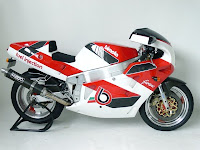The Furano, named after a wind that blew across the Adriatic sea near Bimota's base in Rimini, combined a tuned version of the 1002cc four-cylinder engine from Yamaha's FZR1000 with a light and exotic chassis of the Italian firm's own design.
The bike was hand-built in numbers of just 100 to provide the ultimate in high-speed motorcycling.
The FZR was a fine sports machine in its own right, so using its engine was an excellent starting point.
In standard form the twin-cam, 20-valve lump produced 140bhp with generous midrange torque.
Bimota added a Weber-Marelli fuel-injection set-up and replaced the four-into-one exhaust system with a lighter, less-restrictive design of their own.
The result was a claimed peak output of 164bhp at 10,500rpm.
The engine was bolted to a typical Bimota frame consisting of two aviation-alloy spars, each one hugely thick, beautifully machined and immensely strong.
Suspension parts came from Swedish firm Öhlins, widely regarded as the best in the world.
Both the upside-down front forks and single rear shock absorber were fully adjustable for both compression and rebound damping.
Other cycle-parts were of equally high specification.
The front brake comprised two 320mm diameter drilled Brembo discs, gripped by four-piston calipers.
Wheels were composite, 17-inch diameter items of Bimota's own design; tyres were soft-compound Michelin radials, the massive rear cover measuring over seven inches in width.
Bimota's traditionally high quality of finish was particularly evident in the bodywork, in which reinforcing patches of lightweight carbon-fibre were visible amid the hand-painted fibreglass of the one-piece fairing and seat-tank unit. (Bimota claimed the fibre-bonding Keeping up with - and usually ahead of - the mass-produced motorcycling Jones's is ever the Bimota goal. process was so complex that one fairing in three was rejected.)
More carbon-fibre was used for parts such as mudguards and silencer.
The result was a dry weight of 3961b - typical of a 600cc middleweight rather than a full-blown superbike - which gave the Furano an unrivalled power to weight ratio.
Combined with the fuel-injection's crisp response, the result was awesome acceleration.
At about 4000rpm in first gear, a flick of the wrist sent the front wheel hurtling skywards as (he Furano stormed forward with its tacho needle sweeping towards the 11,500 rpm redline.
Few roadgoing vehicles could come even close to matching the Furano, which flashed from 0-60mph in the flicker of a stopwatch, and screamed through the standing quarter-mile in under 11 seconds.
Top speed was predictably mind-blowing, too, with more than 170mph available given the right gearing and a clear stretch of tarmac.
Even more impressive was the Bimota's handling, particularly the ultra-responsive feel derived from the blend of rigid frame, taut suspension and premium rubber.
The Furano gave no hint of a wobble even at the highest speeds.
Steering was quick and precise; the bike could be slowed hard with a brush of the potent Brembos, flicked into corners with a minimum of effort, then powered out with the fat rear tyre welded to the road.
Advances in Japanese sports bike design meant the Furano could not hope to match the edge that some of its Bimota predecessors had enjoyed over the competition.
Mass-produced Japanese rivals such as Honda's CBR900RR, in particular, provided high power outputs and excellent handling.
The Bimota justified its far higher price by being not only even faster and more agile but also much rarer and more exotic.
It was a hand-built, lavishly equipped superbike created simply to be the fastest and best in the world.






















